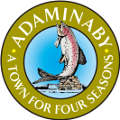Crimson Rosella Nest Boxes and Nesting Diary
Welcome a rosella family to nest at your place
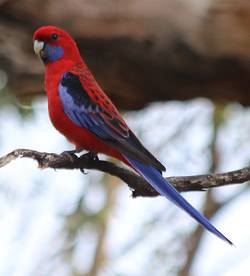
The Adaminaby - Lake Eucumbene district is a major breeding ground for the Crimson Rosellas (Platycerus elega). Rosellas frequently nest within the villages of old Adaminaby and Anglers Reach, much to the enjoyment of residents and visitors. But the demand for nesting sites here exceeds supply.
Why not add a nesting box to your backyard and
enjoy the local wildlife from the comfort of home?
Lake Eucumbene Community Association has a supply of nesting boxes for local families. LECA will also help you with instructions if you want to build your own box. Then you can watch and record the nesting behaviour of local crimson rosellas, take photos and take notice as the fledglings grow and mature.
Join our local nesting box team, put up a nesting box and send in your photos and stories to Nestbox Tales as a rosella family grows up in your own backyard. You can also read other rosella families' stories and post comments.
Crimson rosellas are an ideal bird to select for a backyard nest box. They are accustomed to living closely with humans, and they readily populate artificial nests. They live for about 15 years, mate for life and prefer to use the same nesting site at the same time, every year.
Why do a nest box diary?
This is a great activity for people of all ages and all levels of avian knowhow, physical mobility & fitness. Children, grandparents and visitors can create a rosella diary together.
Show what's happening in your
Adaminaby - Eucumbene backyard. Via Nestbox Tales, you can publish diary excerpts and photos online for everyone to see. Or you can just email rosella news to your friends & rellies, if you prefer.
Nesting box diaries are a low cost, easy-paced activity that fits everyone's lifestyle. Watch the rosellas at your leisure, record as much or little detail as you want, and share your findings whenever you feel inspired.
Nature lovers
Connect with local birds in a non intrusive way. See the rosellas' trust develop over years, as a pair returns annually to nest in your backyard.
Take note of actual observed versus expected
behaviour of crimson rosellas during the nesting season.
Handipeople
If you enjoy woodwork, what about building some rosella nest box(es) for your yard or your neighbours' yards. Check out the best specs through LECA to keep predators and other bird species out.
Rosellas are the ultimate judges of nest box design. See what they think of your skills! Share your successes or failures with everyone by sending in your stories, plans and photos.
Photographers
A nest box creates a great opportunity to photograph rosellas and their chicks. Please send in some great photos to this website. We'll gladly publish them with attribution.
Children, adults, everyone
Enjoy our local crimson rosellas close up. Publish your rosella photos and diary excerpts online, read others' experiences and add your comments online.
Learn more about the usual behaviour of crimson rosella pairs during the breeding season and of young chicks as they hatch and grow.
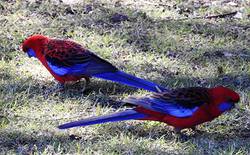
Keeping a nest box diary is a very satisfying, enjoyable pastime every summer season.
Engage with the family life of our Rosella community and notice the behaviour and the seasonal migration of other parrots.
LECA obtained a grant to buy nesting boxes for local use and to publish excerpts & photos from nesting diaries on this website. To participate in the LECA nesting box group, follow the nesting box experiences of others, share photos and stories, please contact LECA.
Keeping Your Diary
The easiest way to maintain a nest box diary is to purchase an inexpensive calendar or short, hardcover paper diary. Keep this exclusively for information regarding activities at the nesting box.
- Note the day that the birds begin inspections and the behaviour associated with selecting a nest site;
- Note the day that the occupancy is confirmed (female remains in the nest and is fed by the male);
- Calculate the dates that you expect:
- Egg laying and incubation - lasts 10 days, female stays at nest
- Hatchlings (chicks eyes close plus 3 days )
- Nestlings rise to feed at nest entrance plus 17 days
- Fledglings emerge from nest to spread wings and exercise legs and flight muscles (Green colouring, plus 20 days
- Socialisation and behavioural skills acquisition - feeding, threat protection and joining a flight with parents (plus 30 to 45 days)
- Nest is vacated and available for new occupants.
Observe the nesting box and write a short description of what you observe and note the dates.
The birds will keep generally to the above cycle, but times and durations may vary. It is not common for birds to abandon a nest during nesting. However, trespass and perceived threats or danger will cause the females to abandon eggs or to evict hatchling chicks.
Your diary will be repeated once the nest is vacated and new occupants commence their cycle.

About My Nest Box Diary 2020-21
by Bill Leane
After many years of being fascinated by the beauty, behaviour and calls of our local crimson rosellas, I decided to keep a diary of their comings and goings via a backyard nesting box. Hopefully, I will develop a long-term relationship with our nesting avian partners, and people visiting my community will also observe the nesting experience and share a similar relationship.
I am also hopeful that the nest diary concept will be sustained well into the future and that locals and visitors can be encouraged to revisit the area to support, follow, and contribute to this important project.
The Nest Box
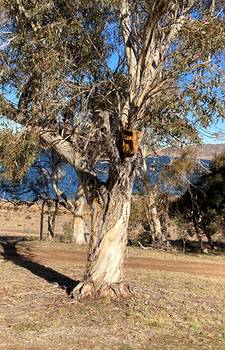 My nest box is a standard commercial nest box design which mimics a natural nesting site: 2m above ground level; NE facing; sized to attract a crimson rosella; constructed to deter predators (currawongs, cats) and unwanted competitors (possums, micro bats).
My nest box is a standard commercial nest box design which mimics a natural nesting site: 2m above ground level; NE facing; sized to attract a crimson rosella; constructed to deter predators (currawongs, cats) and unwanted competitors (possums, micro bats).
The crimson rosella nest box will also attract Eastern Rosellas; but this variety prefers to nest at a slightly lower altitude, below 1000m.
Commercial designs and "flat-pack" nest boxes are available via the Internet and by e-shopping. The most economical way to purchase nest boxes is to consolidate and order for several boxes (5 plus) and request a delivered price for the consignment order of nest boxes.
Sample Nest Box Diary Extract
Old Adaminaby, NSW, 2629
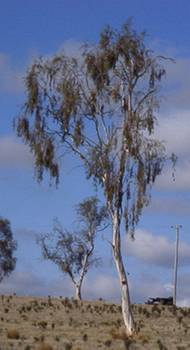 Elevation 1200m, Rainfall 729 mm pa
Elevation 1200m, Rainfall 729 mm pa
Local ecosystem: sub-alpine eucalypt woodland frost hollow
Typical vegetation: Snow Gum Eucalyptus pauciflora, Black Sallee Eucalyptus stellulata; sometimes Adaminaby Snow Gum Eucalyptus lacrimans
It has been a strange breeding season for the birds. We were observing 3 artificial and one natural site. I was uncertain of what impact the January 2020 fires would have had, and it was a bit of wait and see.
We had the boxes installed in good time for the season, although it was a latish start with pairing delayed until late October and early November. When pairing and nest selection started in mid November, things seemed to be going to the normal pattern. There were lots of nest inspections (I saw about 30), and 2 artificial boxes attracted one pair of what we thought were residents. They stayed for 3 or 4 days and then departed, not to return. A similar pattern was evident at the natural nest. Lots of interest but no occupancy.
I am unsure of the reasons for the odd breeding behaviour. The birds were in good health, well fed and with no signs of stress. Clearly, the 20-21 fires had had a devastating impact on the local crimson parrot breeding population; many adults were killed in or trying to escape the firestorm. A year's offspring was lost in the adjacent National Park in or at the nests, but substantial breeding habitat was largely untouched in the eastern perimeter.
I believe that some of the cause of poor breeding lies in my inadequate provision of bedding litter to the boxes. I have inspected other nests and realise that my bedding litter was too coarse. Crimson parrots are known to chew dry bark to make their bedding mix, and this is much finer than what I provided.
More on nestbox design for native birds & mammals....
Nestbox Tales Facebook page - stories & photos from nestbox hosts
